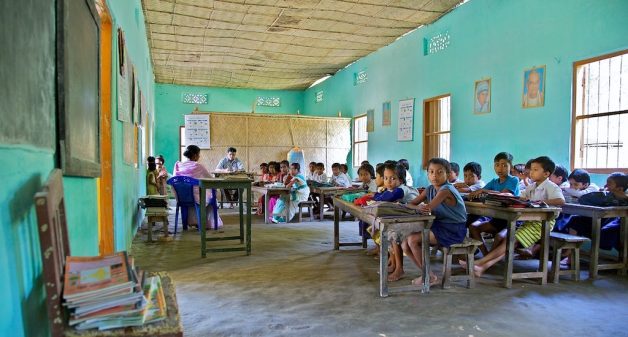There is widespread realization that government schools, particularly in rural India, are not performing and their learning outcomes are poor. Although there are anecdotal stories about extremely well run schools and devoted teachers, they are sadly in a minority. At the same time, we know of the mushrooming of low, medium and high fee private schools. These are touted as English medium and many aspirational rural parents are paying fees to send their children to these schools.
Many think these private schools are more disciplined, more regular, teachers pay more attention, give homework and assess more. They neglect to point out that these are not accessible to those who cannot pay the fees. It is important to think about this as there is also an apparently plausible argument made that private schools are low cost but still manage to ensure children learn. But given the scenario that even those who are in supposedly good schools and showing good results in exams seem to be quite ill-equipped to handle conceptual tasks or questions, the realities in village schools has to be recognized while evaluating the new education 2016 policy.
The 2009 Right to Education Act was a show of good intentions and in one sense certainly made education the right of all children. The equity principle and the idea of common school was, however, diluted considerably. A provision for reserving 25 per cent seats in private schools for economically disadvantaged children meant that the stratified system of schooling was accepted in principle.
Apart from this tacit acceptance and legitimization, there were two important lacunas that were stark. One the fact that the reimbursement to the schools was not according to the fees that the school charged but an arbitrary amount fixed by the government. The second that there was no additional support available to these children to succeed in the highly competitive of private school environment. In addition, the backlash of better-off parents and the kids from elite backgrounds acting disdainfully towards these children was also not considered and taken into account and still is not foregrounded as most elite private schools treat these quota children differentially.
Financial gap
The other major gap in RTE was the absence of any financial commitment to make its goals possible. There were no punitive or corrective steps for the bureaucrats who run the education system at a particular time. The only persons held accountable for learning were parents, children and teachers. The others had to only provide building and teachers of whatever quality and generate data that met the requirements.
They also could direct teachers, monitor them, give them non-teaching tasks, take them out of schools during school times, but have no culpability. In some sense, the headmasters were also considered to be culpable but not anyone else. What is also ironic that the judgments of culpability and fixation of guilt was also left to the appropriate authority, which is the local or state government departments.
Overbearing monitoring
In the years subsequent to the RTE, while the bureaucratic machinery functions to do patchwork on the supply conditions at the schools and generates figures that include half truths, it allows no space on autonomy to the school and the teachers, who have no agency left. Years of overbearing monitoring and tyrannical guidance have left them unconfident and de-motivated. The nature of teacher education has also been bureaucratized and, hence, soaked in so much corruption that they do not even feel competent to teach with confidence. The entire teacher education system is geared towards certification.
The machinery responded to the quality directions in the RTE by setting up traumatic mechanisms to see whether children were achieving the desired levels. What was said in the RTE and by these monitoring mechanism was contrary to the spirit of no detention, which aimed at giving children more time and support. The interpretation of this was that by some miracle children should be learning the class-wise expected content and acquire expected abilities, independent of their backgrounds and conditions. This is also meant that the schools and the children were flooded with a lot of testing pressure and external evaluations by unsympathetic experts, who themselves had never taught in such classrooms and have no background understanding of the children in these schools.
Given this situation, the major challenges before the new education 2016 policy were not only about clarifying the purpose of education but also about the governance and implementation of education. The need to make community central to this process and simultaneously transform the attitude of the education system to them was intense. This includes having the voice of the rural disadvantaged heard in schools and the school system as a whole to respect persons of disadvantaged backgrounds.
Policy disappointment
The policy formulation in the 2016 exercise was seriously disappointing in all these aspects. They have acknowledged and accepted all the inequities and stratification not as a challenge but as a inevitable fact. The underlying belief is that education is for providing fuel to the economy and there are some children who are more meritorious than others and they need to be identified and nurtured right from the beginning.
Most children will not end up in academic or administrative jobs and have any significant need for education. They would only require base mechanical skills to be able to perform cheap labor intelligently and be consumers of the advertised market. There is no need for a common enriched classroom or expectations for them and the focus should be towards training them for some low status role in the economy.
The policy framework, instead of interrogating the failure of the system to arrive at the goal of equitable quality education for all, and responding to the challenges of the system being made to act as a filter and agent of stratification, accepted this as its role. The placement of human being not as a citizen but as a human capital to be harnessed for the good of the nation stood out clearly.
Purpose of education
It was also evident that education was being interpreted as a skill development and training program. In a direct way this accepts that the major purpose of education is to find a job based on that. The idea of universal education as essential to enrich the experience and joy of life was and is ignored. The way it was defined and has moved forward, it does not make any case for the rural poor to invest in the education of their children.
One of the main challenges for education todays is the cost to run schools. The expectation was that the policy would be forthright in acknowledging the need for a greater education on education and correct the steps that had been left hanging so far. The tilt of the policy, however, is in the other direction. There is a cut back in spirit and in reality on the resources available and utilized. The policy does not take cognizance of the large absences and vacancies in critical positions of education and the non-children education and sometime even non-school pulls and pushes on the teachers.
It does not articulate the need to make for the school and the teacher the most critical answerability to the children, their parents and the community. It does not state the need to rediscover the purpose of education with the community as a participant and bring them in to the dialogue and in implementation. Instead, the clear takeaways from the draft are that children could be differentially treated and most children should be given skills training.
Question of governance
The policy fails to address the question of governance and administration, which has been recognized as one of the major bottlenecks in the ability of the system to make quality education possible to all. The need for a fair and supportive system that respects, supports and encourages teachers, children and the community and moves towards reduced centralisation, gives up on over-governance as well as oppressive and vacuous monitoring, has been forgotten.
This requirement has been underlined in the position paper on systemic reform as far back as in 2005. This theme has recurred in many places where programs and structures have been reviewed. The policy framework did not have that in its design. The recommendations therefore are towards more monitoring, more testing and more pressure on the schools and the teachers. It strengthens the tacit recognition that some children are only meant to receive limited education and that government structures and systems would not function and, hence, privatize at all levels.
Focus on teachers
The new policy does not examine the ideas of making teachers central and empowered to make choices or if they are allowed to develop and explore their ideas along with the children. It does not look at the sources of their demotivation and alienation. The policy and the discourse around it has given up the effort to construct pragmatic mechanisms for decentralization, autonomy and shared responsibility.
It has not questioned the myths of standards and outcomes and the excessive competition and anxiety that is linked to it and is set to have elements that would exacerbate it. There is no recognition of the diversity of the background and the patience towards building equitable opportunities with celebration of the learning. Rather it is homogenisation and imposing the hegemony of elite learning purposes and expectations with no empathy for the need of patience for children from different backgrounds.
Rural-urban divide
The building of consensus around equity raises questions about the inequity between the rural and the urban and even more in the context of the stratification in village society. Economic growth has created an aspirational space in rural India, where the consumption of urban goods and investment in urban infrastructure and education system seems to be the appropriate thing. This will worsen as the pressure on land and the economy increases.
The educational policy has ignored this and has strengthened the interests of the dominant and powerful. There were some hopes but more fears from the new policy, given the nature of the discourse. The conversations are around greater pressures and early specialization, discarding the ideas of holistic, plural and inclusive education. There seems to be a pushback to providing support and promised resources for the public system of education.
The steps for systemic reforms seem to make the teacher and the school furthermore at the beck and command of administration. The limited purpose of education as a filter and as a instrument for producing citizens useable for able to use the market seems to be drawing the maximum attention.
Hriday Kant Dewan is educational advisor to Vidya Bhawan Society, a non-profit that promotes the Gandhian ideals of basic education. He was earlier with Eklavya Foundation in Madhya Pradesh, which works in the area of education.



